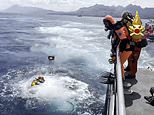As Putin bombs a children's cancer hospital but Starmer talks of defence reviews and roadmaps, how Poland is on a mission to build the most powerful land army in Europe
As the sun beat down on a glorious summer day, cyclists clad in lurid fluorescent Lycra pedalled furiously along the road. A woman walked her small dog along the pavement, while a middle-aged couple stretched outside their house before setting off on a jog.
I was on the outskirts of Warsaw, the Polish capital, but this sort of contented scene could have been observed in suburbs across Europe — only it would not have been accompanied by the constant crack of gunfire bursting through groves of towering pine and silver birch trees.

Polish volunteers join a military training camp
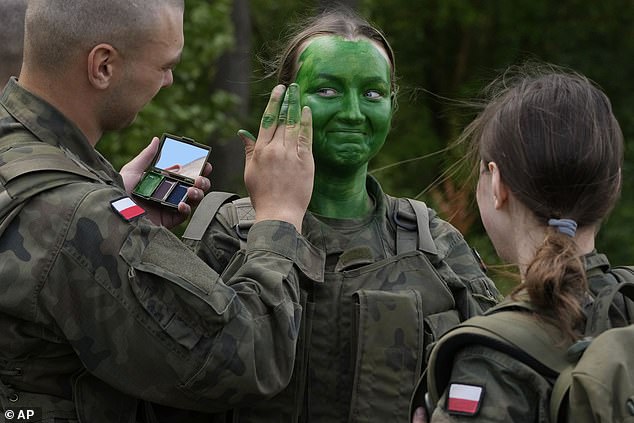
A Polish recruit has camouflage applied during training
The shots came from a military training ground hidden behind metal fencing twice my height and topped with spirals of razor wire. Signs in Polish, English, Russian and German warned people to keep out and not to fly drones overhead.
Piotr Placha — one of 20 men and women who honed their skills on the 100-metre shooting range for more than two hours — emerged wearing full military uniform, including beret and body armour, with a pistol strapped to his belt and Kalashnikov rifle slung over his shoulder.
Learning to use a pistol, he said, was crucial for close-quarter fighting — and might have a more macabre purpose, too, since in extremis you could turn it on yourself.
‘In this part of the world we know that you don’t want to be captured by the Russians,’ he explained.
This impressive-looking character is not a soldier, however. He is the 51-year-old father of two sons, who works in a city-centre office for the Polish export agency.
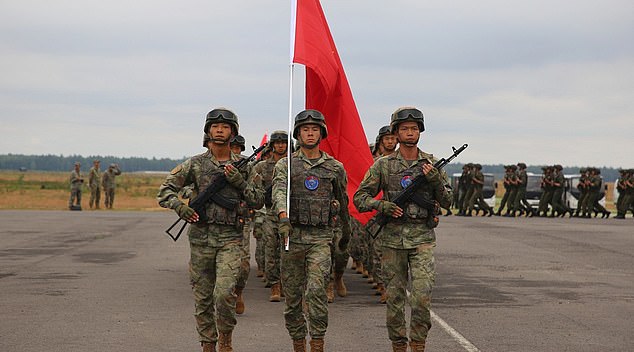
Earlier this week, the Mail reported how Chinese troops were on patrol just three miles from the Polish border, staging an exercise with Putin’s ally, Belarus, and giving a disturbing indication of Beijing’s affiliation
But as an experienced sport shooter, Placha decided after Russia’s attack on next-door Ukraine to join a voluntary group pushing for Poland to be better prepared for conflict — and now he trains with the military as the nation beefs up defences.
For this east European nation — which has been to war with Russia 27 times over the years, as well as suffering four decades of Soviet subjugation — has responded to Vladimir Putin’s aggression more dramatically than any other country on our continent.
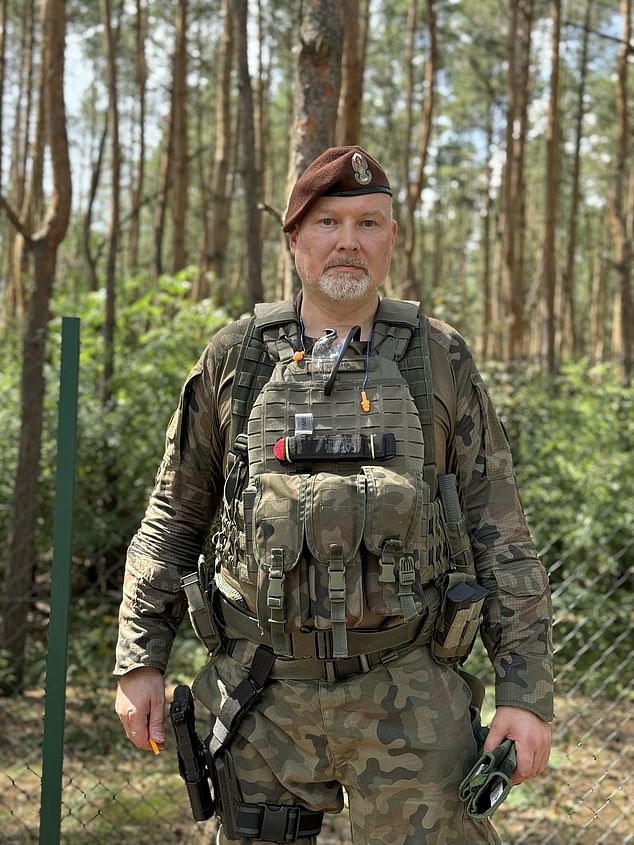
Piotr Placha — one of 20 men and women who honed their skills on the shooting range for more than two hours — emerged wearing full military uniform, including body armour, pistol and Kalashnikov slung over his shoulder
As Western leaders gathered in Washington yesterday for a summit focusing on bolstering support for Ukraine to mark Nato’s 75th anniversary, Sir Keir Starmer called on recalcitrant allies to raise their defence spending, saying there was ‘no more important duty’ than guarding the nation.
Sources say his Government plans to boost the UK’s spending to 2.5 per cent of GDP from its current 2.32 per cent level. Yet it has already scrapped Rishi Sunak’s promise to reach this target by 2030 — causing deep alarm among defence experts who say there is no time for delay. Instead, it is launching a review to assess the threats to the UK and set out a ‘roadmap’.
The attitude could not be more different here in Poland, which has embarked on a rapid mission to build the most powerful land army in Europe.
This involves more than doubling the size of its armed forces, a massive spending spree on weaponry and the development of a network of citizen militias.
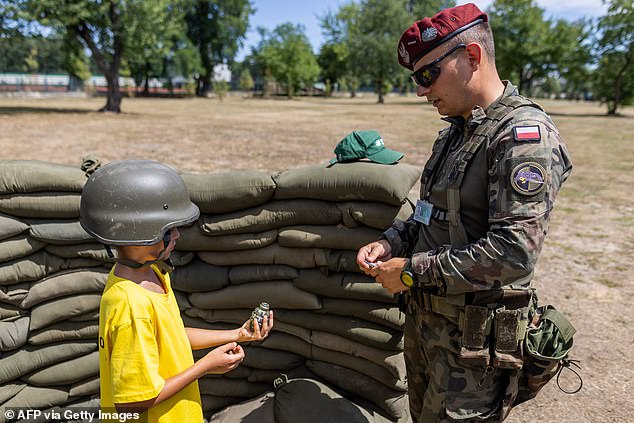
A Polish Scout holds a mockup grenade as he learns how to throw grenades during a military training day at the Polish Army's summer programme

While another Scout throws a fake grenade as he learns how to throw the explosive
Poland has tripled its defence budget since Putin launched his onslaught on Ukraine in 2014 by seizing Crimea and attacking the Donbas region in the east of the country. Its ambition is exemplified by a plan to have more tanks than Britain, France, Germany and Italy combined.
The country’s level of defence spending is now the highest in Nato. More than 4 per cent of its GDP is going on fighter jets, air defence systems and long-range artillery from the U.S., as well as naval frigates and missiles from Britain, helicopters from Italy, howitzers and hundreds of tanks from South Korea.
Yet despite spending more than twice Nato’s guideline rate, Poland’s leaders say they are ready to keep driving it up. ‘If Putin really threatens us, we will double it because we will not be a Russian colony again,’ vowed foreign minister Radoslaw Sikorski.
And it is not just Russia. Earlier this week, the Mail reported how Chinese troops were on patrol just three miles from the Polish border, staging an exercise with Putin’s ally, Belarus, and giving a disturbing indication of Beijing’s affiliations.
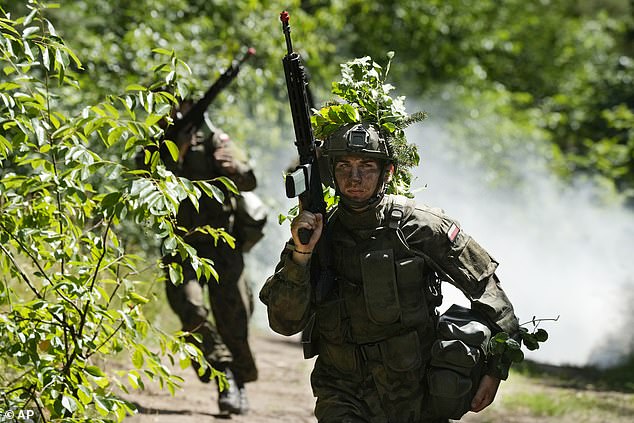
The 28-day ‘holiday’ teaches combat and survival skills - at the end, volunteers take a military oath swearing ‘to serve loyally the Republic of Poland… even at the cost of losing my life or blood’
Poland’s stance challenges the complacency of the other Nato members gathering in Washington as the shadow of a Trump presidency looms over the summit. He has criticised many of them for failing to pay their way and warned that, unless they do, US co-operation in combat cannot be guaranteed in future.
In Warsaw, they are leading the way. ‘There is relative political consensus in Poland about our military upgrade,’ says former defence minister Bartosz Kownacki, head of their Nato delegation.
‘If Putin wins in Ukraine, then the rest of Europe is next — and Poland is on the frontline.’
Their astonishing build-up — heavily focused on offensive weapons to hit command and logistics hubs deep in enemy territory — is intended to send a stark message to the Kremlin: Russia will pay a heavy price if it dares attack Poland.
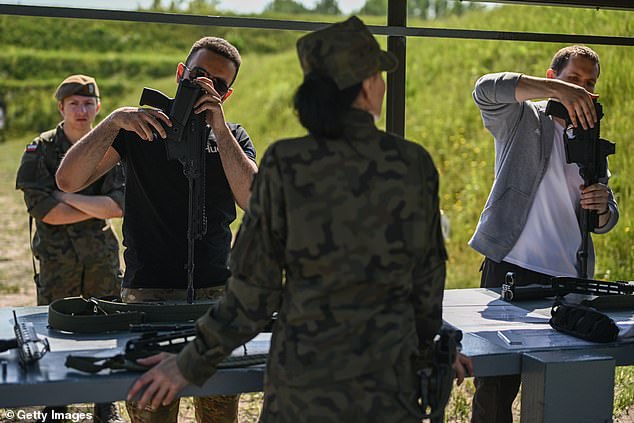
Civilians learn how to assemble assault rifles as they take part in a one-day military training
This spending blitz was partly designed to restock squadrons and battalions depleted by donations of equipment to Ukraine after Russia’s full-scale invasion of 2022, which included about a dozen fighter jets and 300 of the army’s 750 tanks. One beneficial by-product of this move has been the replacement of old Soviet weaponry with the latest Western technology.
But Poland is also fortifying its domestic defence. It will have 80 ultra-modern U.S. fighter jets designed to ensure air supremacy in any future conflict with Russia.
Its latest £582 million deal with the US will equip them with 821 long-range, air-to-ground JASSM-ER stealth missiles, ensuring they can reach enemy positions almost as far away as Moscow.

Poland plans on more than doubling the size of its armed forces, a massive spending spree on weaponry and the development of a network of citizen militias
‘The Ukraine war has confirmed everything that we thought about the Russian military,’ says Michal Piekarski, a defence specialist at the University of Wroclaw. ‘It has shown that much of the effort Russia put into modernising its military has gone nowhere and they have reverted to their traditional approach, with waves of men — the meat-grinder tactics — and relying on lots of obsolete weapons.’
Piekarski argues Russia would need about 400 of its best aircraft to counter Poland’s new fleet of US-built jets. He fears the Polish navy is currently too weak, but will be boosted by three frigates being built as part of a joint venture between Britain’s engineering giant Babcock and a Polish firm.
‘This will make it very hard for Russia to strike us from the sea because they will confront some of the best ships and missiles in the world,’ he said.
Poland’s standing army has doubled in strength over the past decade to 200,000 troops, with the aim of more than doubling that total again to 450,000 by 2039 — although critics say this is unrealistic given the country’s shrinking population.
If this growth is achieved, however, Poland would have three times as many full-time troops as the British Army, despite the fact the UK has approaching twice its population.
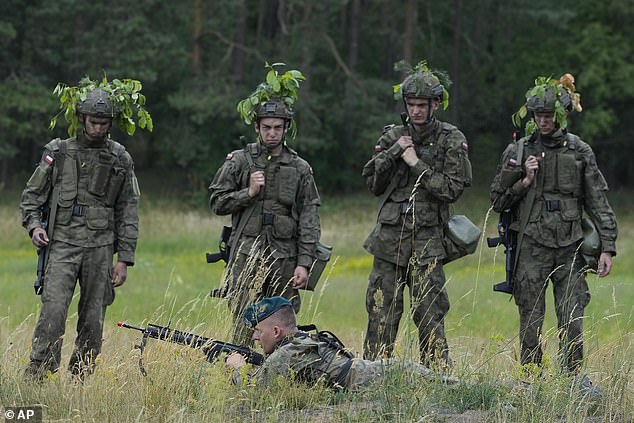
The land army learns new skills as they prepare to protect their country from the likes of Russia
The most controversial purchases for this European Union member came as a result of £11.5 billion worth of arms deals with South Korea for 48 combat aircraft, 1,000 tanks, 672 howitzers and 288 multiple rocket-launchers — for mounting on infantry fighting vehicles.
Polish experts told me they share a desire to strengthen Europe’s defence manufacturing base but were concerned about the ability of German firms to deliver parts on time to keep their arsenal in a battle-ready state.
This re-armament drive is fuelled partially by fears over the rise of hard-Right populism in Europe — with some leadership figures in some Nato allies echoing Putin’s propaganda — and worries about the possibility of Donald Trump reducing American aid to Ukraine.
‘Ukraine teaches us you must be as self-reliant as possible — and then you see the allies you feel are most reliable,’ says Wojciech Lorenz, head of the international security programme at the Polish Institute of International Affairs.
‘I won’t say who are less reliable but in Poland we see the US and UK as among the most reliable.’ Polish analysts believe two factors will influence Putin’s calculations over launching war with Nato: the strength of armed forces ranged against him and his success in Ukraine in grabbing terrain and exposing divisions in democracies.
Moscow has made persistent efforts to turn Poland’s citizens against Kyiv, inflame hostility to Ukrainian refugees and intensify divisions in society, including by sending waves of migrants from its vassal state of Belarus.
One disinformation expert told me a video showed Belarus security forces training migrants how to stab soldiers in areas of their body unprotected by armour. A Polish soldier was stabbed to death on the border last month.
The government has accused Russia of ‘likely’ involvement in a conflagration that burned down Warsaw’s biggest shopping centre in May, destroying 1,400 outlets. ‘We should not expect direct invasion in one or two years but we can expect there will be activities by Russia and its allies on the threshold of war,’ says Tomasz Piotrowski, operational commander of Poland’s armed forces until last year. ‘We are already suffering cyber attacks, sabotage and fires that seem highly suspicious.’
The general welcomes the military build-up but wants Poland to spend more on critical infrastructure, such as roads and bridges, to support Nato forces.
There has been debate over whether to reintroduce conscription. The military has launched a series of initiatives offering training for a day with troops and ‘holidays with the army’, which is giving basic military training to 11,000 Poles over the summer.
The 28-day ‘holiday’ teaches combat and survival skills at 70 locations. At the end, volunteers take a military oath swearing ‘to serve loyally the Republic of Poland… even at the cost of losing my life or blood’.
Among shaven-headed volunteers training in a forest-clearing near the Belarus border was Dominik Rojek, 18, who planned to study computer science but now plans a military career to defend his nation. ‘Someone has to do it,’ he says.
One strand of this strategy was the creation of a Territorial Defence Force, which has 5,000 full-time soldiers and 35,000 part-timers to protect Poland.
Recruits include Elzbieta Snarska, 38, mother of a four-year-old girl, who lives near the Belarus border and has been trained in shooting. ‘It feels dangerous these days because we have to think about Russia and military conflict,’ she says. ‘But I feel proud of myself.’
About 200,000 Poles also hold gun permits — including Barbara Szkiladz, 33, an office administrator in Warsaw. ‘I believe war is coming to Poland,’ she says. ‘I am from a family of hunters and I will use one of my father’s guns to protect myself, my family, my friends and my cat when the war comes. I don’t care if the Russian soldier is a teenage recruit — if he enters my property, he is dead.’
One thing is certain, as Europe’s free nations are menaced by Putin’s dictatorship, Poland’s stance puts Britain and the rest of Nato to shame.






















